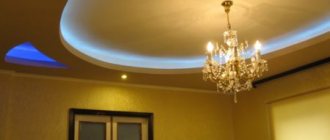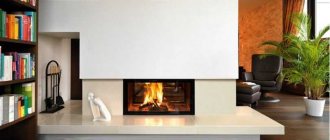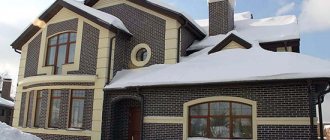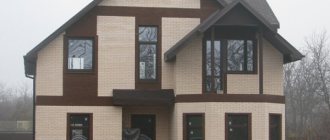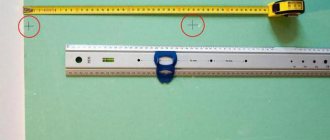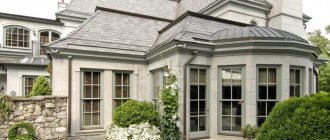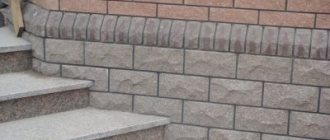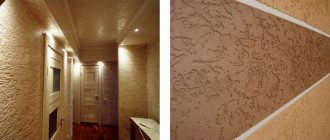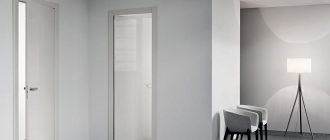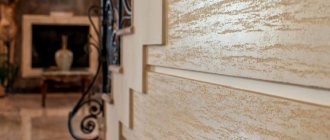Hi all! Today I want to talk about such a material as external drywall. Recently a friend asked me if it was possible to sheathe a façade with it. I said that aqua panels would be more reliable, and that drywall, even moisture-resistant, should not be used for exterior decoration. It copes with humidity, but only in buildings and rooms. If you still bought drywall, then make the facade in 2 layers, and treat the joints with silicone-based putty. It is also possible to increase resistance to moisture by painting. But you also need to buy silicone-based paint. Let's take a closer look at how to carry out all the steps of the process.
What is the difference between external drywall and regular drywall?
Special sheets are used to decorate the façade of a house with plasterboard. They are treated with hydrophobic impregnation. GCR has the following properties:
- energy saving - heat remains in the house, cold does not enter the room;
- moisture resistance – this drywall does not allow moisture to pass through. Fungus and mold do not appear on the interior walls of the room;
- sound insulation – noise from the street is practically inaudible in the house;
- façade plasterboard does not deform under the influence of weather conditions.
On the practical side, there are the following properties:
- the smooth surface of the plasterboard makes the facade beautiful and attractive;
- there are a lot of finishing options;
- working with plasterboard does not take much time;
- the insulation laid between the walls and drywall is not exposed to external influences of temperature and moisture;
- façade plasterboard is safe for people and the environment;
- at low temperatures, drywall does not deform or burst.
With all the positive properties there are some disadvantages:
- The facade of the house cannot be covered with any other type of plasterboard, except for façade gypsum plasterboard.
- If drywall is constantly exposed to water, it will become deformed.
- If the drywall sheets are constantly exposed to high temperatures, the structure will collapse.
- GCR is fragile and breaks easily, so work should be carried out carefully and carefully.
When a set of deficiencies occurs, it is necessary to handle the gypsum board accordingly.
How to properly store GVL?
Store GVL
should be done in rooms with dry or normal temperature and humidity conditions. The manufacturer guarantees that the quality of the sheets meets the technical specifications provided that the consumer complies with the conditions of transportation and storage. The shelf life of the sheets is one year from the date of manufacture.
Interesting materials:
When to plant violet seeds? When to plant phlox seeds? When to plant herbaceous hibiscus seeds? When to plant hot pepper seeds? When to plant hydrangea seeds? When to plant clove seeds? When to plant chrysanthemum seeds? When to plant lily seeds? When to plant lupine seeds? When to plant juniper seeds?
Which profile to use when sheathing a house with plasterboard on the outside
To prevent the profile from rusting, use an aluminum type.
For exterior finishing, use a special aluminum profile coated with an anti-corrosion compound. It is produced by pressing. There is a profile of normal and increased strength.
Properties of aluminum profile:
- The weight is light.
- Durability – able to withstand a certain weight.
- Rigidity – does not bend during installation and operation.
- Aluminum profiles are available in different sizes.
- The frame made of profile lasts a long time.
- Using this profile it is possible to manufacture curved structures.
- Working with this building material is simple and easy.
- Aluminum profiles do not contain toxic substances and are therefore safe for health.
When creating a frame from a facade profile, it should be taken into account that the fasteners must be treated with an anti-corrosion compound. After installation, the space should be filled with thermal insulation material. This is mainly polystyrene foam or construction wool.
If the house is made of natural stone, the frame is not mounted. After fixing the heat-insulating material, the sheets are attached to the wall with special fasteners.
Cladding the facade of an adobe house
You can sheathe an old façade using both expensive and more affordable materials. Moreover, modern building materials used for the exterior decoration of a private house make it possible to carry out this amount of work in a short period of time. In addition, the facade cladding will not only perform a decorative function, but also serve as an additional thermal protective layer for a worn-out structure.
Facade cladding
Here it is worth immediately making a reservation that external finishing made of brick or cinder block will strengthen the house. This is very important for heavily worn-out buildings (with a wear rate of more than 40%).
Materials for covering a house with external plasterboard
Primer. To treat the surface outside, a soil mixture is used:
- façade primer – anti-corrosion. Prevents rust;
- antiseptic – prevents the appearance and spread of fungus and mold, fights the appearance of beetles and other pests;
- primer with deep penetration - for greater adhesion of building materials;
- hydrophobic composition – prevents the penetration of water and moisture;
- universal primer - has many properties and is widely used in outdoor work
Putty. It has the main task of withstanding temperature changes and alternating high humidity and dryness.
Putty can be of 3 types:
- starting – base;
- finishing – main. With its help, the surface is leveled and prepared for subsequent decoration;
- universal - can be used as a base or finishing finish.
When finishing exteriors, it is important to choose the right plaster.
The qualities that universal putty has: elastic, frost-resistant, durable, breathable, quick-drying, does not contain toxic impurities. This putty is easy to work with and sands well. The composition of putty mixtures is:
Which is better: heated floors or radiators?
Warm floorBatteries
- polymer – suitable for outdoor use;
- cement – there is shrinkage;
- polyurethane - universal composition;
- gypsum - not recommended for street work, because does not tolerate moisture well.
With the right choice of building materials, finishing the facade of a house with plasterboard will not be difficult and will not take much time.
How to properly use drywall for exterior use
To create a beautiful individual house facade, you will need to create a metal frame. Elements must be galvanized to prevent rust. Before installing frame parts, you should prepare the surface. The facade must be clean and without hanging finishing materials. If there is a “belly” in the plaster or “fur coat” of the house, it should be removed. It is also necessary to remove the old whitewash. There should be no dust, cobwebs or dirt.
The surface is primed to prevent the occurrence of fungus and pests. After the primer has dried, this process is quick in the open air; markings should be made. Stretch the fishing line and hang plumb lines (to make the surface even). Installation of profiles begins along the perimeter of the wall, do not forget about windows and doors. After fixing the guide profiles, you should work on the vertical posts and horizontal struts. Each mounted element is checked for evenness with a level.
The metal frame should be made under the very roof and with a slight approach to the foundation line. Once the roof is sheathed, the top edge of the plasterboard wall will be hidden. Below, when insulating the foundation, the lower edge of the facade trim is sealed.
After installing the metal profiles, a corrugated wire is laid on top to illuminate the street. The entire surface is insulated with insulating material.
Reconstruction of an old house: arguments in favor
Choosing the option of demolishing a building requires the preparation of appropriate documents, which in itself is expensive. In addition, it entails a lot of costs.
To build a new house you will need:
- Demolition of the old building, followed by removal of construction waste;
- Permission to build a new one, purchasing a project for a new house and other paperwork, accompanied by a waste of money and vital energy;
- Making a foundation, pouring a screed, erecting a box, a roof and other labor-intensive processes;
- Connecting main communications (in this case, it is necessary to very accurately calculate the permissible load on the power cable, determine the correct slope of sewer pipes, etc.);
- Internal lining of all surfaces of rooms.
Reconstruction of an old house
All this work sometimes takes years to complete. And not everyone can afford such a luxury, while repairs can be completed in the shortest possible time and the walls can be covered with high-quality materials, investing significantly less money.
So, for reconstruction we need:
- Cladding the façade;
- Carry out interior finishing;
- If necessary, replace the old roofing material with new one;
- Carry out cosmetic repairs to the walls of the premises.
How to install drywall on exterior surfaces
Drywall is attached to different surfaces:
- Tree (log house).
- Brick walls.
- Concrete walls.
- Cement board.
- Cinder block surface.
Almost any building material from which the house is laid out is made of a metal frame from galvanized profiles. After creating the frame, the strength and evenness of the surface are checked. Sheets can be fastened both longitudinally and transversely. Drywall sheets should be attached first to the corner of the house.
Fastening occurs according to the rules:
- Fasteners must be galvanized or have a special anti-corrosion coating. The hardware is screwed in by hand.
- Self-tapping screws should have a sharp tip and a semicircular head.
- Fasteners are installed every 20 cm.
- The screws should be turned in a level position.
- There are 15 hardware for 1 square meter.
Knowing these rules, attaching drywall to the frame will not be difficult.
Installation of gypsum boards on a metal profile
When cladding external walls, waterproof plasterboard sheets are often fixed to a steel frame. The fasteners are self-tapping screws with a semicircular head. If the thickness of the guide parts and posts exceeds 0.7 mm, it is worth using fasteners with a special drilling end.
The screws must be 2.5 cm long or more, with a diameter of 3.5 mm. It is extremely important that the self-tapping screws used to fasten the GLK material have a protective coating. It will prevent the occurrence of corrosion processes.
When attaching facade plasterboard, a certain step should be observed: in the center of the slab - 30 cm, along the outskirts - 20 cm.
Attention! When screwing in the screws, you need to make sure that they penetrate perpendicularly into the frame profile.
Moisture-resistant plasterboard for exterior use is best mounted on a steel frame Source i1.wp.com
How to cover external wooden walls with plasterboard
This type of interior work is carried out using the frame method of installing gypsum boards on the walls, and you can choose either a wooden or metal frame. It all depends on the complexity of the design. After installing a frame made of wooden mounting strips or a galvanized metal profile, sheets of drywall are installed on it using standard self-tapping screws.
The advantages of such finishing can be considered the usual list - ideal alignment of the walls, simple and quick installation, the ability to lay communications into the thickness of the wall, elimination of complex preparatory work, relatively low cost of the process, installation by yourself is quite possible.
How to build a plasterboard wall yourself?
Materials for the construction of plasterboard walls
After drawing up a project or drawing based on the dimensions taken from the location of the wall, it is necessary to make a list of all the necessary materials so that during the work it does not turn out that something is missing and you do not have to interrupt work and run to the nearest hardware store.
| Illustration | Brief characteristics and purpose of materials |
| KNAUF metal guide profiles, for example PN 100×40 mm for fixing to the ceiling and floors. 100 – profile width in millimeters, which will determine the thickness of the frame. If you add two more thicknesses of plasterboard, the wall thickness will be at least 125 mm. If this is a lot, you can use other similar profiles with a smaller width, for example, PN 50x40 (finished wall thickness - 75 mm), or PN 75x40 (wall 100 mm thick) | |
| Rack-mounted metal profiles for vertical racks and lintels installed inside the structure. The illustration shows KNAUF PS 100×50 mm, but, as mentioned above, narrower ones, PS 50×50 or PS 75×50, can be selected. | |
| Sealing self-adhesive sealing tape Dichtungsband of the appropriate width (95, 70 or 50 mm, depending on the width of the selected profiles). It is intended for gluing onto guides and rack profiles for their tight connection with walls, ceilings and floors. Thanks to this tape, the structure acquires soundproofing qualities - the effect of impact noise transmission is significantly reduced. | |
| GKL wall plasterboard sheets measuring 1200×2500×12.5 mm. For the bathroom, as already mentioned, gypsum plasterboard is used, and if the wall being erected is located in close proximity to the stove or fireplace, then it is better to use gypsum plasterboard. | |
| Reinforcing perforated paper tape for joints of drywall sheets. Fiberglass mesh can also be used, specially produced in narrow strips, and even often with a self-adhesive side. | |
| Dowel-nails measuring 6x40mm for attaching guides to load-bearing surfaces. | |
| Self-tapping screws for plasterboard for metal - for fastening profiles together (you can use “bugs” or self-tapping screws with a wide press head, as shown in the illustration), and for fixing plasterboard sheets to the structure. The most popular self-tapping screws are 3.5x35 mm or 3.5x25 mm. No longer required | |
| Drywall primer can be clear or white. The latter is most often used in cases where the surface is prepared for wallpapering. | |
| Drywall putty used to seal joints and screw holes, and then to apply a continuous thin layer to the wall surface. The putty can be purchased in paste form (much more expensive) or dry form (requires preparation). | |
| Mineral insulation with a thickness corresponding to the thickness of the intended wall. For living rooms, it is better to choose medium-density basalt material. Brands of insulation are directly intended for sub-frontal purposes. For example, “ISOVER Warm Home”, “KNAUF Acoustic Partition”, “URSA PUREONE”, “ROCKWOOL Light Butts SCANDIC”, “ACOUSTIC GROUPE Schumanet BM” and others have proven themselves to be excellent. | |
| A wooden beam, with a cross-section that will correspond to the width of the metal profiles for bookmarks, as well as for forming a door frame. |
Tools for installation
Without the necessary tools, as you know, it will not be possible to carry out any construction work. To erect a plasterboard wall, you will need a minimum tool kit, which includes:
| Illustration | Purpose of the tool |
| Laser (better) or regular bubble level for precise marking. A level is also necessary when installing the frame - to monitor the correct installation of parts. | |
| The painting cord will allow you to quickly and efficiently create a straight line on any surface. | |
| A plumb line, even if you have a laser level, can still help - with its help you can quickly and accurately project the lines of the wall from the ceiling to the floor, thanks to which the partition will be installed perfectly vertically, without tilting. | |
| A tape measure is necessary for any construction work; when erecting a plasterboard wall, you also cannot do without it. | |
| A construction square will be required for marking the wall, marking and cutting profiles and sheets of drywall. Squares are produced in different versions and you should choose the one that is more convenient for work. | |
| A hammer will be required when attaching guides to permanent surfaces (ceiling, floor, walls). They are used to drive dowel nails. | |
| A special knife for drywall or even its stationery “brother” is for cutting sheets. | |
| A hacksaw or electric jigsaw can also be used to cut sheets. | |
| Metal scissors or a grinder for cutting profiles. Hand tools are safer to use and do not damage the galvanized layer when cutting. | |
| A hammer drill is necessary if profiles have to be fixed to concrete surfaces. Sometimes it is quite possible to do without it if the material to which the profiles are attached is “pliable”. | |
| A screwdriver will help you quickly install profiles and drywall to the frame. | |
| A set of spatulas, 3÷4 pieces, from the widest (about 400 mm) to the narrowest (50 mm). necessary at different stages of wall filling. | |
| Roller or wide brush - for applying primer to drywall before finishing work | |
| A construction float with replaceable attachments is needed for grouting joints where the putty composition is hardening, and for smoothing the wall after puttying. | |
| Cutter. It is good to have this tool on hand, as it will significantly speed up the connection of metal frame elements. If it is not there, the profiles can be connected with metal screws. |
Some nuances of installing plasterboard partitions
Before moving on to a step-by-step examination of the process of constructing a plasterboard wall, it is necessary to consider the features of some of the work so as not to return to these issues further.
- The frame for plasterboard sheathing can be made not only from galvanized metal profiles, but also from ordinary wooden beams. The second option will cost a little more, but the strength of the structure will, perhaps, be even higher.
If timber is chosen for the frame, then the horizontal jumpers are attached to the vertical posts with metal corners, of which four pieces (two on each side) are required to fix one part. For reliability and stability, they must hold the block both above and below.
Prices for popular models of screwdrivers
An example of a detailed diagram of the installation of a wooden frame under plasterboard sheathing.
- Frame trim parts (frame) fixed to the permanent surfaces of the room.
- The vertical posts of the frame are necessarily made from solid timber.
- Horizontal frame jumpers that give rigidity to the structure.
- The jumpers are secured to the vertical posts and trim beams using metal corners fixed with self-tapping screws.
- Fastening the frame to permanent surfaces - dowels and nails.
- When attaching adjacent sheets of drywall, the edges of the two sheets are fixed to the boundary part of the frame, forming a joint. If each vertical or horizontal row of drywall consists of several l
The joints of the plasterboard sheets should be spaced according to the principle of bandaging in masonry.
ists, then the joints of different rows should be spaced apart. The seams between the sheets must necessarily fall either on a vertical post or on a horizontal jumper. Hanging joints are not allowed.
The recommended pitch between the centers of vertical posts is 600 mm.
- Due to the fact that the standard width of a plasterboard sheet is 1200 mm, and it must be fixed along at least three lines, along the edges and along the center line, the vertical posts are positioned so that the distance between their axes is 600 mm.
The head of the screw slightly pierces the outer cardboard layer and plunges into the sheet by about 2 millimeters.
- Fixing gypsum board sheets to the frame is done using special screws for metal or wood (depending on the material of the frame). The head of the self-tapping screw, after screwing it in, should be recessed into the drywall by 2÷3 mm - special bits for a screwdriver with a “skirt”-limiter are convenient for this.
When screwing in a self-tapping screw using such a bit, the limiter will rest against the surface of the sheet and will not allow you to accidentally “rip” the sheet through.
The screw head will be exactly at the depth required by the technology. The space above the cap is left to be filled with putty - this way the fastener will become completely invisible. The sheets are fixed to all posts and lintels of the frame, screws are screwed in in increments of 150÷200 mm.
Prices for waterproof drywall
waterproof plasterboard
Cutting drywall is a simple process, however, it requires accuracy and precise movements.
- It is very important to cut drywall correctly: if you do not know how this process is performed, you can ruin the material. A broken or even slightly cracked sheet is no longer used for installation on the wall as a whole. True, from its entire part it will be possible to subsequently cut out the necessary parts of smaller sizes.
To obtain an even fragment of gypsum board of the required size, you must first mark it on a whole sheet. A line is drawn along the marked points. Then, applying a metal ruler to it, a cut is made along it with pressure with a sharp knife.
A break in a cut sheet of drywall along the cut line.
At this stage it is important to cut the top layer of drywall. After this, the sheet is laid so that the cutting line is on the edge of the table. Light pressure is applied to the area protruding beyond the tabletop with your hand, due to which the gypsum layer breaks exactly along the cut line. All that remains is to cut the bottom layer of cardboard with a knife.
Cutting the edge of drywall - forming a chamfer for subsequent puttying.
- If you have to join two pieces of sheet that do not have a factory chamfer, then you need to make cuts along their edges with a knife or a special plane. The total width of the cuts should be approximately 10 mm. This groove is necessary to fill it with putty, which, together with the reinforcing tape, will bind the sheets together.
Doorway in a plasterboard wall.
- If a doorway is planned to be installed on the wall being built (and this is most often the case), it should be reinforced with timber. This is done in different ways:
- instead of a galvanized profile forming an opening, you can immediately use timber;
— wooden parts can be inserted into the internal space of a metal profile;
- instead of one metal post on each side of the opening, two are installed, at a distance of 50 mm from each other, and a wooden door frame is then installed in such a reinforced doorway.
- Experts recommend attaching two layers of plasterboard to the installed wall frame - this will increase the strength and soundproofness of the structure.
Cuts on the metal profile and the possibility of subsequent bending.
- If it is necessary to form parts with corners from a metal profile, cuts on its walls must be made at an angle. It is easier to carry out this process with metal scissors, but you can also make cuts with a grinder, taking the utmost care.
To ensure an even bend in the metal, the cuts on both side walls must be identical.
The lower part shown in the figure is often made, for example, to form the lintel of a doorway.
The gap between the floor surface and the bottom edge of the plasterboard sheathing.
- When installing plasterboard sheets on the frame, it is necessary to leave a deformation gap of 10÷12 mm wide between the plasterboard and the floor surface. To simplify this task and make the gap even, several scraps of the same drywall can be laid on the floors before installing the sheet in place. After attaching the sheet to the frame, these liners are removed. And the gap, depending on the type of room, is filled either with sealant (for example, in a bathroom) or with polyurethane foam (in rooms with normal operating conditions).
These were general recommendations, and now let's look at an example of how a plasterboard wall can be erected.
Construction of a plasterboard wall - step by step
The table below will show you step-by-step the process of constructing an internal plasterboard wall.
| Illustration | Brief description of the operation performed |
| The first stage of work is always marking the surfaces of the room in which the wall will be installed. This problem is best solved using a laser plane builder. He will immediately determine and mark the necessary lines on the ceiling, floors and opposite walls. If this device is not at hand, then a building level, a plumb line, a metal ruler and a marker are used for marking. First, a line is determined on the floor surface. To do this, the same distance along the side walls is set off from the parallel wall in several places. Then the painting cord is stretched from one point to another, and with its help a line is struck on the surface. It should form a right angle with one and the second side wall. Next, the line must be fixed by drawing a marker along it, having first laid down a ruler. | |
| Focusing on the horizontal line of the floor, vertical projections on the side walls of the wall are determined from it - the most accurate thing in this matter will be a plumb line. The top line of the future wall is determined by connecting vertical lines on the ceiling on opposite walls - it is also easiest to mark it off with a paint cord. The ceiling and floor lines must be ideally in the same vertical plane. You can check their correct location using a plumb line - as shown in the illustration | |
| Now, on a line drawn on the floor, you should mark the location of the future doorway, according to the drawn up project. As a rule, the width of interior openings is 800 mm. There may be other sizes, but when leaving an opening, the width of the door and the parameters of the door frame must be taken into account. | |
| The next step is preparing profiles for mounting the frame. First, the necessary measurements are taken and, if required, cutting. It is better to immediately prepare all structural elements that will be attached to permanent surfaces. Then, on those planes of the profiles with which they will be pressed to the surfaces of the walls, floor and ceiling, sealing tape is glued. | |
| First, the guide is attached to the floor along a line marked on its surface. To do this, the profile is laid on the floor, 100 mm is retreated from the wall - the center of the hole is marked. Then the first hole is drilled through the profile in the floor. | |
| A dowel-nail is immediately installed and driven into the hole with a hammer. Thanks to this precaution, the profile will be fixed to the floor in the required position, and drilling the remaining holes will be much easier. | |
| The profile is fastened in approximately 500 mm increments. When drilling the following holes, you should ensure that the profile does not move from the drawn line. | |
| The edge of the profile facing the doorway is fastened with a distance of 200 mm from it. This is necessary so that there remains free space for fixing the vertical strengthening and forming doorway racks that are installed in this place. So that the head of the dowel-nail does not interfere with installation. | |
| Next, the metal profile is attached to the ceiling. It is desirable that the profile be solid, but if it has to be made up of two segments, then their joint should not be located above the doorway. | |
| When the horizontal profiles on the floor and ceiling are fixed, they are connected by vertical guides fixed to the walls. Vertical posts are inserted inside the horizontal guides. They are fastened using a cutter or metal screws. | |
| The next stage is marking and installing vertical rack profiles. As mentioned above, a distance of 600 mm should be maintained between the center line of two adjacent profiles. The racks are inserted into the guide profile and fixed with a cutter or metal screws. When installing racks, it is very important to control their vertical position using a building level or plumb line. Particular attention should be paid to the racks that form the doorway, as they must be secured perfectly perpendicular to the guides. | |
| The posts framing the doorway must be fixed more rigidly in the structure. It is desirable that they be additionally reinforced with a wooden beam, which is inserted and secured inside the metal profile. For the outer pillars of a doorway, it is more convenient to use reinforced perforated profiles, but regular pillar profiles are also suitable. | |
| Special strong perforated corners are screwed to the edges of the outer racks; they are fixed with screws and nuts, but the latter are not completely tightened, leaving the possibility of adjusting the height of the rack at the installation site. The ability to adjust the height is only possible if you use a perforated profile and corners - that is why they are more convenient during installation. | |
| The stand is installed on the corners in the guide profiles on the floor and ceiling. | |
| The end posts must be checked for perfect verticality using a building level. | |
| After this, holes in the floor are drilled through the holes in the corners through the guide profile - for dowel-nails. | |
| Dowel-nails are installed in the holes and hammered into the base. | |
| Next, the nuts are finally tightened on the mounting screws. This will secure the bottom of the rack. | |
| After this, the upper side of the rack is secured in the same way to the upper guide profile. That is, two holes are drilled in the ceiling through the corner and the guide profile, through which dowel-nails are driven. Then, after finally checking the correct position of the drains, the nuts on the mounting screws are tightened. | |
| Next, the height of the doorway is determined and marked on the vertical posts. Usually it lies in the range from 2100 to 2300 mm. The width between the posts is measured - it is necessary to make a horizontal lintel that limits the opening in height. | |
| A horizontal jumper is made - usually from a guide profile. You will need a segment, the length of which is the sum of the width of the doorway and the side folds, with the help of which the lintel will be attached to the vertical posts. The length of the bends can vary from 200 to 300 mm. The profile section is marked, and then cuts are made according to the markings using metal scissors. Then, the side parts of the profile are bent at right angles relative to the horizontal part of the part. An example of a cut was previously shown in the illustration when the basic principles of installation were discussed. | |
| The finished jumper is installed in the place marked for it, while its bent parts are put on vertical posts. Next, using a level, check its horizontalness. | |
| The jumper is secured with self-tapping screws on both sides of the racks. You will need two or three self-tapping screws on each side of the fastening, depending on the chosen length of the bends. Additionally, it is recommended to strengthen the lintel with a wooden tab, laid and secured in the horizontal part of the lintel. | |
| The completion of strengthening the doorway structure is the installation of vertical jumpers that will connect the ceiling guide and the horizontal jumper that limits the doorway. Typically, two parts are used for this. If a wooden tab is installed in the lintel, then the edges of the vertical posts are trimmed and the fixation is made outside the horizontal lintel. If a wooden insert was not used, then the vertical posts are inserted inside the upper and lower guides, and then secured with a cutter or self-tapping screws. The distance between the main vertical post and the auxiliary reinforcing post should be approximately 150 mm, which will also add additional rigidity to the structure. | |
| When the frame is completely ready, wiring is laid inside the structure, if necessary, the locations of sockets and switches are determined, and cables are connected to these points. To make the wiring safe, it is recommended to pass the cables into a special corrugated insulating tube. All connecting nodes must be well insulated. | |
| Having completed the installation of the frame, you can proceed to covering it with plasterboard. Installation of sheets usually starts from the main wall. The bottom sheet of material is attached first, and one should not forget about the deformation gaps that should be left between the gypsum board and the capital surfaces. If the first vertical row of sheets has horizontal joints, then in the next row the joints should “spread” at a distance of at least 400 mm from the joints of the sheets of the first row. The distance between the horizontal lintel of the doorway and the nearest joint between the sheets must be at least 150 mm. | |
| In order to prepare the part that will be fixed above the doorway and to the side post, dimensions are taken from the place of its planned location. And then a fragment of the required configuration is cut out from the gypsum board according to the parameters taken. In this case, it is necessary to take into account the location of the vertical posts above the doorway, as well as the fact that the edge of the cut panel should extend half the width of the first or second post - for fastening with self-tapping screws. | |
| Next, the second side of the doorway is sheathed - the work is carried out according to the same principle. After this, the next row of sheets is installed and so on until the end. The last sheet of mail will probably also require trimming to fit. At the same time, the recommended spacing of joints is observed - as mentioned above. Having completed the installation of drywall, those edges of the sheets that do not have factory chamfers are cut at an angle - this was discussed earlier. | |
| The next step is to seal the joints with putty, onto which reinforcing tape is glued. Another layer of putty is applied on top of the tape. On this bottom layer of drywall, it is not yet necessary to cover the screw heads with putty. | |
| After the putty composition has dried, a second layer of drywall is mounted on the wall (if so provided for in the project). When installing it, it is necessary to ensure that the joints of the lower layer of sheathing do not coincide with the joints of the upper one, both horizontally and vertically. Trimming the edges, filling and reinforcing the joints of the outer layers of the cladding is done a little later, already simultaneously on one and the other side of the mounted wall. | |
| If you planned to install a socket in the wall, then the socket for the socket box is drilled at this stage - this will require a special drill bit for drywall. Then the cables are brought out through the hole, and a socket box is installed into which the socket or switch will be mounted. The socket boxes for plasterboard have a special design and are fixed by tightening the screws that press the stops on the back side of the cladding. | |
| Having completed the covering of one side of the wall, insulation material is laid on the other side between the vertical posts. It should fit as tightly as possible to the frame elements. After laying the insulation, the second side of the wall is covered with plasterboard. It is clear that approximately according to the same algorithm as the first side. | |
| When the second side of the structure is sheathed with two layers of plasterboard, edges are trimmed on both sides at the joints of sheets that do not have a chamfer. Then they need to be treated with a primer. Next, putty is applied to the joints, reinforcing tape is glued onto it, onto which a layer of putty is applied. Next, the joint lines are puttyed and reinforced, and in addition, the holes from the heads of the fastening screws are also treated with putty. When the putty has dried, the areas where it was applied should be leveled with a float. | |
| The next step is first dust removal, and then continuous priming of the surface. This stage of work is preparatory for the final leveling of the entire surface with putty. | |
| For any finishing coating, a plasterboard wall must be filled with a thin layer of mortar. This must be done so that between, for example, wallpaper and cardboard there is a layer of putty. Otherwise, during the next repair, when removing the old, tired or unusable decorative wall covering, part of the cardboard will come off along with it. That is, the integrity of the entire wall can be seriously damaged. The putty layer, after it has dried, must be sanded well to perfect smoothness - both for painting the wall and for wallpapering. An exception can be made only for facing with ceramic tiles - here ideal smoothness is not needed. After the wall is completely leveled by sanding, it is primed again - for the subsequent finishing. |
How is a plasterboard wall prepared for finishing?
The instructions in the table only touched lightly on the operation of preparing the sheathed wall for finishing. And this is an important issue that requires considerable skill and deserves separate consideration. Therefore, we invite the reader to go to the instructional article on our portal “Puttying drywall under wallpaper .
* * * * * * *
So, erecting a frame partition wall and covering it with plasterboard is a completely doable task even for a novice builder. Feel free to get down to business - and if you try, everything should work out!
Let’s conclude the article with a video in which craftsmen share their secret of constructing a partition with soundproofing capabilities.
External plasterboard: installation on a brick facade
All that is needed to start work is to choose the method of installing drywall, tools and materials, the correct dimensions and markings of the walls.
In this case, it is possible to finish the walls with plasterboard without a frame, if the difference in its plane is small and it is possible to use the adhesive method. If the difference is slightly different from the permissible one, you can always level the transition with special beacons made from pieces of plasterboard. If the difference is large, or the wall has significant defects, then it is better to use a frame.
Try to follow the algorithm, accurately take measurements and mark the wall for the frame and drywall sheets, install the structure efficiently and do not forget about the final finishing.
Drywall for external facade finishing
Exterior walls take on a stylish look.
A popular trend in cladding materials in construction is various façade panels. Plasterboard systems are a practical and modern way of finishing a facade.
Plasterboard panels for facades are an acceptable and optimal option for insulating external walls
buildings, reliable, highly effective protection from winds and moisture. Drywall for facade work has a unique, special structure that resists moisture, ensuring the moisture resistance of the material.
Features and technological data of external drywall
Due to hydrophobic impregnation, drywall for facing work outside the house becomes a reliable protective screen from natural, weather and climatic influences. Such slabs for external use are a productive energy-saving coating that is used for water and thermal insulation, leveling the effects of wind and air currents.
The material prevents the blowing out of fibers of heat-insulating materials, heat loss from the heat-insulating layer, and the penetration of moisture into the insulation.
Operating data of gypsum boards for external work:
- Aesthetically attractive appearance of facade finishing;
- Individuality of finishing;
- Resistant to moisture absorption;
- Long service life;
- Simplicity of exterior arrangement;
- Wind protection for any wind rose;
- Wear resistance;
- Resistance to temperature changes;
- Prevents the insulation from drying out;
- Environmental Safety;
- Frost resistance;
- Thermal insulation abilities.
Drywall for facade finishing is a means of wind protection. It adjusts the air pressure without reducing its vapor-permeable qualities.
Installation of drywall on a wooden frame
If the basis for a moisture-resistant gypsum board is a wooden frame structure, then when installing the material it is important to follow the following recommendations:
- Fastening is carried out using self-tapping screws, nails, staples. The use of the latter requires the use of special pneumatic tools.
- Metal fasteners must have a protective anti-corrosion layer.
- The recommended distance between fasteners along the edges of the panel is 15 cm, in the middle - 20 cm.
- You need to start the process of fixing the sheet from opposite corners.
- Depth of insertion of fixing parts: nails - 12 diameters, staples - 15, screws - more than 2 cm.
If, during fixation of gypsum boards for external work, the fastening element is deformed, then it must be removed. In this case, further fastening is carried out at a distance of 5 cm from the previous place.
The wood for the frame must be dried to 20% humidity, otherwise the timber will move and the structure will warp over time Source ob-otdelke.ru
Disadvantages of drywall for outdoor use
Despite all sorts of advantages, advantages and affordable cost, plasterboard has a number of limitations in its use for outdoor work:
- Facade cladding is performed exclusively with material specialized for this type of work;
- Prolonged contact with water leads to deformation of the sheets;
- Prolonged exposure to elevated temperatures leads to destruction of the structure of the slabs;
- Installation work and processing of gypsum boards is carried out carefully, due to its fragility.
Features of façade gypsum boards
Facade plasterboard panels serve not only to give an aesthetic appearance, but also to insulate buildings, protect against wind and exposure to atmospheric moisture. Therefore, facade gypsum boards have a special structure - the outer cardboard layer is impregnated with a special hydrophobic composition, due to which moisture does not penetrate into the cardboard.
In addition to protecting the house from the effects of precipitation and air currents, plasterboard sheets serve as an energy-saving coating that prevents warm air and insulation fibers from blowing out. Particular attention should be paid to the beneficial performance characteristics of this building material:
- treating the walls with plasterboard makes them perfectly smooth;
- contains only natural ingredients, which is why it is considered environmentally friendly;
- not exposed to temperature changes;
- We are vapor permeable, which prevents moisture from accumulating in the insulation;
- easy to install;
- fireproof material;
- serves for many years without repair;
- does not require special care during operation;
- affordable.
When choosing a gypsum board you need to know:
- For façade cladding, only special moisture-resistant boards are used;
- prolonged contact with water leads to destruction of the slabs;
- cuts well and is highly flexible.
Exterior finishing with plasterboard
Installation work involves the construction of a frame. The façade material and base are marked. This type of drywall is easy to cut and can be processed; it is installed on the surface:
- Wood and lumber;
- Covered with siding;
- Brick walls;
- Cement slabs.
Installation of slabs is possible in the longitudinal and transverse directions to the sheathing of the metal frame. Installation of sheets begins from the corner of the house. In this case, make sure that the vertical joint above the door frame or window is above the opening, and not the vertical post that limits it. With the longitudinal installation method, the vertical seams are shifted by one step of the frame posts. To achieve the highest possible air permeability, joints along the horizontal axis are avoided. To do this, attach drywall as long as the height of the wall.
A non-hardening type of sealant is applied to the joints. This measure will protect the core of the sheet from moisture and increase breathability. With high-strength masonry walls of the house, drywall is attached directly to the wall with screws.
A few words about installation
Facade gypsum plasterboard has its own fastening features:
- Facade plasterboard is mounted on a finished frame, which can be cement slabs, brick walls, lumber and wood, or a specially prepared metal frame. The slabs can be installed both lengthwise and crosswise.
- The installation should begin from the corner of the house so that the vertical joint does not fall above the vertical post of the doorway. Therefore, before starting work, markings are carried out on the base and gypsum board slabs.
- To ensure tightness, the joints must be sealed with non-hardening sealant.
- The slabs are fastened to the base using galvanized hardware or screws that have an anti-corrosion coating. You can carry out the work manually or use a special tool.
Drywall is also successfully used for interior decoration. We talked about this here.
How to use drywall for exterior work
Fastening is carried out with galvanized hardware or screws coated with an anti-corrosion compound. The size of the screws is selected in accordance with the thickness of the structure frame. Hardware is screwed in manually or using a pneumatic tool. Features of external work on covering the frame with plasterboard:
- Self-tapping screws with a sharp end and a semicircular head are used;
- The head of the screws should not damage the integrity of the cardboard;
- The step for attaching the slabs to the frame slats is 20 cm;
- The screws are screwed in at an angle of 90 degrees;
- The approximate consumption of hardware is 15 pieces per square meter of gypsum plasterboard.
Façade profiles: for external mounting
For external work, an aluminum anti-corrosion profile is used. It is made by pressing. The composition includes aluminum and its magnesium alloys.
The strength of the product depends on the chemical composition of the alloy. By indicator:
- Normal strength;
- Increased strength.
Performance characteristics of aluminum profile:
- Ease;
- High load-bearing strength;
- Sufficient rigidity;
- Large selection of sizes and models;
- Durability;
- Versatility;
- Plastic;
- Resistance to aggressive environments;
- Does not accumulate static charge;
- Possibility of implementing designs of any complexity;
- Smooth surface;
- Easily amenable to all types of processing;
- Easy installation;
- Thermal conductivity;
- Does not deform under the influence of temperature changes;
- Fire safety;
- Not high cost;
- Environmentally friendly material.
Moisture resistant exterior drywall
A moisture-resistant analogue for facade finishing (GKLV) is widely represented on the construction market by various manufacturers. The material is not afraid of water and has high water-repellent properties. GKLV for external work differs:
- Contains antiseptic components;
- Reinforced with fire-resistant properties;
- Huge range of standard sizes;
- Versatility of use;
- Sufficient plasticity;
- Simplicity of installation work;
- Thermal insulation qualities.
Moisture-resistant boards are installed in a double layer. The first layer is attached with dowels, the second is glued. For additional protection, they are coated on both sides with a hydrophobic spray. The joints are filled with a hydrophobic insulator.
Finishing the balcony with external plasterboard
The cladding of the open-type balcony is made with moisture-resistant plasterboard. The balcony is pre-insulated and protected from atmospheric influences. Double-glazed windows are installed, taking into account the following factors:
- A frame is built under the glazing and secured to the load-bearing wall of the building;
- Insulate the balcony floor;
- The glazing must be airtight.
Sequence of work:
- Lay electrical wiring for lighting;
- Install the frame sheathing under the insulation and on the ceiling;
- All cracks, seams and joints are filled with polyurethane foam that does not contain toluene;
- Drywall is installed, fastening is carried out with self-tapping screws;
- Seal the seams;
- Treat with primer and putty the surfaces;
- They begin to carry out the final decorative finishing work.
Decorative columns made of external plasterboard
Drywall for facade finishing is flexible, easily takes the desired shape, so its scope is varied. Owners of private housing construction can experiment and look for non-standard ways of exterior design.
Facades with columns are always an impressive type of decoration. Gypsum plasterboard columns perform an exclusively aesthetic function. They visually increase the height of the building. Types:
- false columns are a decorative design to give your home an individual style. They are hollow inside, this space is used for original lighting, water pipes and other communications are hidden in them;
- Support columns are unattractive concrete products that are sheathed with plasterboard.
Tips for decorating residential buildings:
- Several columns are installed - one column is not acceptable, the symmetry of the elements is important;
- The style is maintained by the columns in the same style that was used to decorate the entire house.
